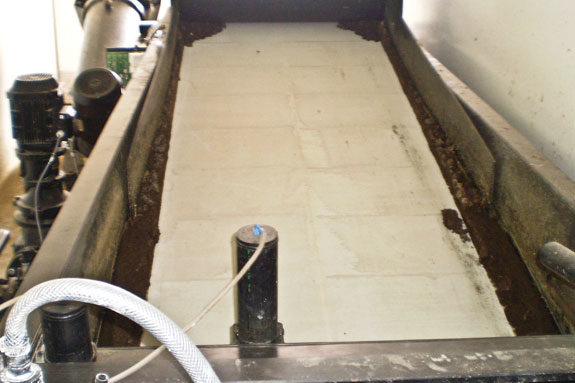Phosphorus is an abundant nutrient in dairy manure – sometimes more abundant than what an individual dairy needs. Now, thanks to a two-step chemical/mechanical process developed by Kemira and available through Environmental Resolutions, dairymen can remove and bind much of the phosphorus to the manure solids, thus leaving the liquids low in phosphorus and ready for irrigation.
The system starts with an influent pump that pulls manure into a mixing chamber. There, polymers are added to the manure. These organic polymers consist of high molecular weight compounds with both positive and negative electrical charges for flocculation. Next, a coagulant is added to increase flocculent strength and help bind and separate the fibers.
The manure mixture is then carried over a single-pass band screen to remove the water as it pulls away from the solids and flows under the belt. Seventy to 80 percent of the solids remain on top of the screen and bound up in those solids are 83 to 95 percent of the phosphorus and 30 to 40 percent of the nitrogen.
From the screen the solids enter a screw press to facilitate removing more liquid and increasing the dry matter content of the solids.
The remaining liquids contain about 0.75 to 1.2 percent solids and are now ready for irrigation. “The levels of phosphorus are so low you can put a lot more on the fields,” says Patrick Hartzell with Environmental Resolutions. He adds that without the solids to suspend the liquids, the crops and dry ground better absorb them.
The nutrient-rich solids can be composted, used for field application or transferred off the farm to others in need of fertilizer.
This system is not for every dairy, Hartzell says. Those that have 4,000 to 5,000 acres and are in need of nutrients to replenish cropland won’t need to separate them out. However, dairies with 6,000 cows and only 600 acres that have to haul manure a long way could really benefit from this technology.
The machines can process 60 gallons of manure per minute or 75,000 gallons per day. Hartzell estimates that one system is required for every 3,000 cows.
This system works even better following a digester, he says.
“The heat from the digester helps the chemicals react better with the manure.”
He also notes that the thicker the manure the better, and recommends at least 5 percent solids. If it is too thin, more chemistry is needed to bind the nutrients.
Still new to the U.S., this system has been in Europe for 20 years, mostly on swine operations.
Utilizing this system can help a dairy better comply with its nutrient management plan and save money on transporting nutrients without the weight of the water. PD
—For more information, contact Troy Hartzell, general sales manager, at Environmental Resolutions at troyh@farmoreofidaho.com or (208) 280-1857.




